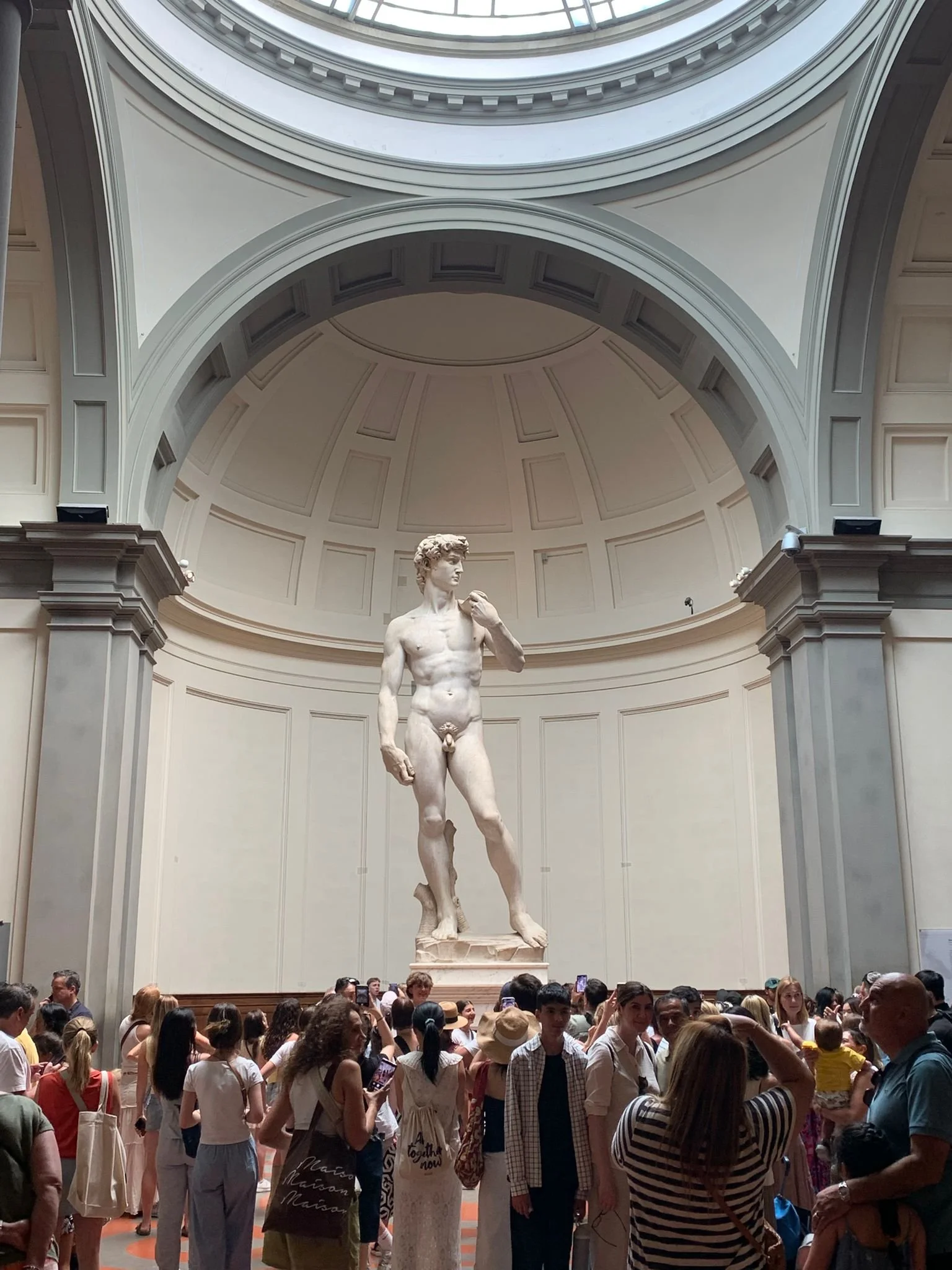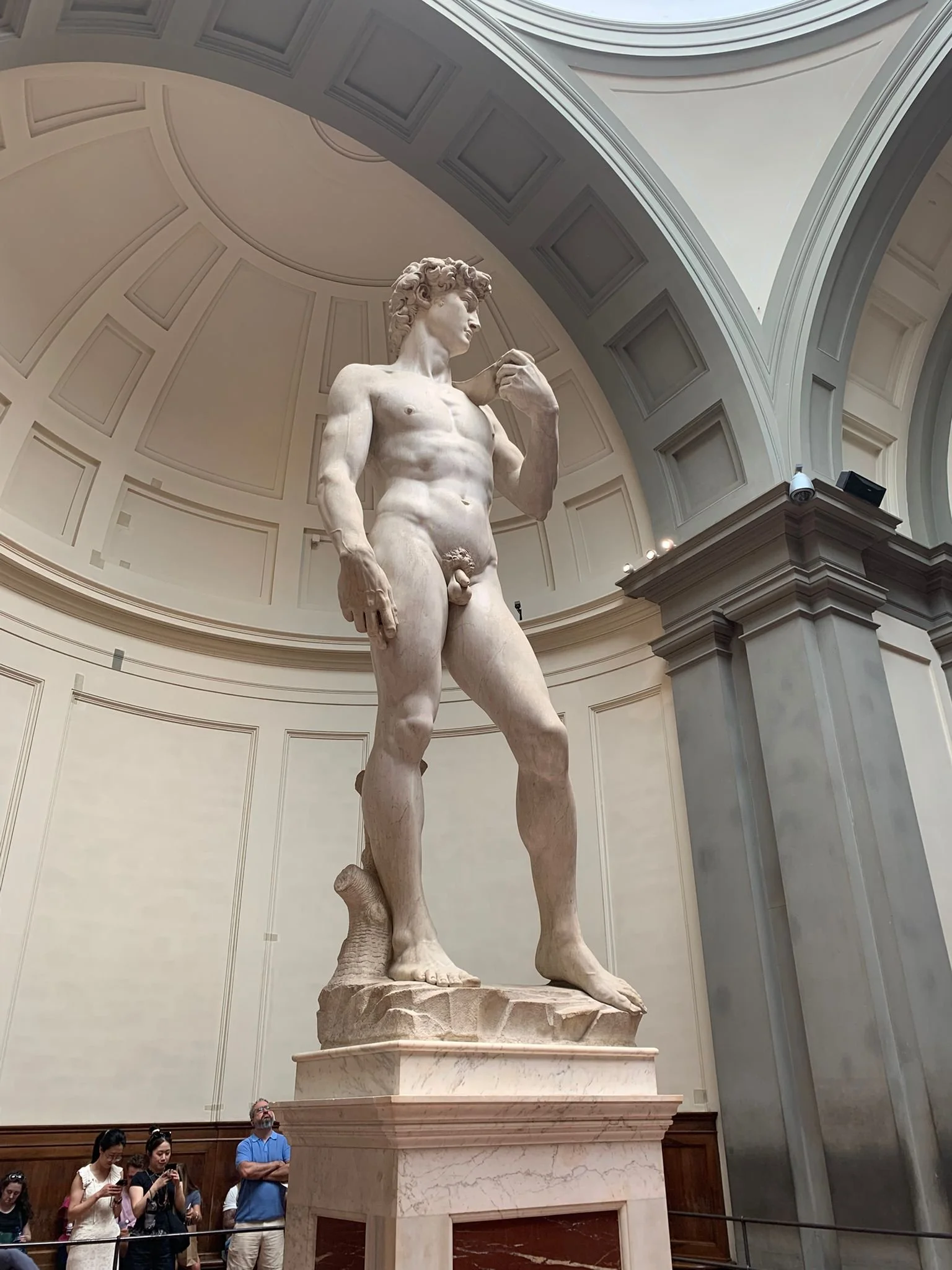Michelangelo’s David: A Marble Symphony of Strength and Elegance
Michelangelo Buonarroti’s David, sculpted from 1501 to 1504, stands as an emblematic masterpiece of Renaissance art, representing not only artistic brilliance, but also embodying the profound cultural values of its time. Originally commissioned for the Cathedral of Florence, David emerged from a colossal yet problematic block of Carrara marble, which other sculptors had abandoned due to inherent flaws. Michelangelo, however, perceived within its imperfections an extraordinary potential, thus manifesting his visionary approach. By overcoming these technical challenges, he not only crafted a statue of exceptional beauty but also symbolically transformed the stone itself into a metaphor for human potential, resilience and redemption.
Standing over five meters in height, the statue's sheer physical presence commands attention and reverence. Its scale itself symbolizes power, but Michelangelo’s vision went beyond mere grandeur - he infused David with subtle yet profound layers of symbolic significance. Through meticulous anatomical detail, the artist demonstrated unparalleled mastery of the human form. Each muscular contour, from the defined pectorals to the graceful yet powerful curves of the limbs, reveals deep study of anatomy, influenced by Michelangelo’s extensive dissections and scholarly examinations of classical art. In its poised stance, known as contrapposto - where weight rests naturally on one leg, creating a delicate yet dynamic balance - the statue conveys an illusion of motion and life. This subtle, calculated imbalance imbues the marble with kinetic energy, suggesting readiness and contemplation simultaneously. Thus, David is not merely a depiction of physical beauty, but a deliberate embodiment of philosophical ideals of balance, reason and harmony central to the Renaissance worldview. His perfectly proportioned form reflects a mathematical understanding of the human body, echoing the Vitruvian principles that were central to Renaissance art and architecture. The calm intensity in his gaze and the poised stillness of his stance suggests not impulsive action, but thoughtful preparation - a moment of rational deliberation before the storm. In this way, David becomes a symbol not only of youthful strength, but of the human capacity for self-mastery, intellect and moral virtue. By marrying naturalism with idealism, Michelangelo created a figure that resonates with the Renaissance belief in humanity’s potential to shape the world through reason, will and art.
Michelangelo’s David stands in deliberate contrast to earlier Renaissance interpretations of the same biblical hero, particularly those by Donatello and Verrocchio. Donatello’s bronze David, created in the 1440s, is often credited as the first freestanding nude sculpture, since antiquity. Unlike Michelangelo’s monumental and idealized vision, Donatello’s David is markedly smaller in scale and possesses an ambiguous, almost androgynous sensuality. His body is soft and youthful, his posture relaxed, even casual and he stands with one foot resting on the severed head of Goliath. Donatello’s emphasis lies in triumph after the fact - a contemplative, introspective mood that invites reflection on vulnerability, divine intervention and perhaps even homoerotic undertones, a reflection of the nuanced courtly and humanist culture of 15th century Florence.
Verrocchio’s David, sculpted around 1473–75, offers a more assertive and martial figure. His David is clothed, alert and slightly older than Donatello’s - projecting the self-confidence of a young soldier rather than the mysterious charm of a divine instrument. With a hand on his hip and a sword at rest, Verrocchio’s David displays the satisfaction of victory, a cool, confident attitude typical of the rising civic pride and militaristic ethos of late 15th century Florence. Though dynamic and lively, it remains within the boundaries of narrative closure - we see a hero after the action, composed and victorious.
Michelangelo’s interpretation, however, marks a radical shift both in scale and psychological depth. Sculpted a generation later and at over five meters tall, David is monumental not just physically, but intellectually and emotionally. Unlike Donatello and Verrocchio, Michelangelo chooses to portray David not after his triumph, but in the tense, contemplative moment before battle - his body coiled with restrained energy, his brow furrowed in concentration, his sling barely visible. This innovative decision to freeze time in the moment of psychological anticipation rather than resolution elevates the sculpture into a philosophical meditation on courage, moral responsibility and human potential.
By focusing on this pregnant moment of decision, Michelangelo expanded the narrative potential of sculpture, pushing beyond literal storytelling toward a symbolic and introspective realism. His David is not a boy, nor a soldier, but a thinking being - the embodiment of the Renaissance ideal that intellect, reason and inner strength are as heroic as brute force. In this way, Michelangelo redefined the image of David, transforming him from a biblical victor into a universal icon of humanistic virtue and the power of rational contemplation.
Michelangelo’s decision to depict the biblical David in full nudity also reflects a broader theological and cultural shift unfolding during the Renaissance - a growing confidence that divine beauty and spiritual truth could be expressed through the idealized human form. In earlier medieval traditions, nudity was often associated with shame, sin, or vulnerability and religious art typically emphasized modesty and moral instruction over sensual aesthetics. However, the Renaissance revived the classical Greco-Roman belief that the human body, when perfectly proportioned and harmoniously rendered, could serve as a vessel for higher truths. This philosophical transformation, influenced by thinkers like Marsilio Ficino and the resurgence of Neoplatonism, embraced the idea that physical beauty could reflect divine perfection - that form and spirit were not inherently opposed but could be united in art.
By sculpting David not only nude but with anatomical precision and idealized balance, Michelangelo reclaims the body from the realm of shame and places it within the domain of sacred symbolism. David’s unclothed form becomes a visual theology - one that celebrates human dignity, rationality and virtue as expressions of the divine. This balance of sacred subject and classical aesthetics marks a key tension and harmony at the heart of Renaissance spirituality: a worldview that sought to reconcile Christian faith with humanist values, where beauty was no longer merely decorative but deeply moral and metaphysical. In David, nudity is not provocative but pure, not carnal but contemplative - a celebration of the body as God’s most perfect creation.
Yet, beyond anatomical mastery, the profound psychological expression captured within the sculpture is where Michelangelo's genius truly emerges. The statue portrays the young biblical hero, David, at a precise moment of tension and contemplation before facing the giant Goliath. Unlike previous interpretations, Michelangelo does not depict David triumphant post-victory, but instead captures the anticipatory tension before the decisive action. David’s gaze is fixed sharply into the distance, eyes reflecting both intense concentration and quiet confidence - a testament to Michelangelo’s sophisticated understanding of human emotion and thought. His face, youthful yet resolute, symbolizes the intellectual strength, moral resolve and spiritual depth inherent in the Renaissance humanist ideal. The contemplative expression emphasizes a central humanist belief: that intellectual fortitude is as essential as physical prowess, making David a profound reflection of the philosophical currents of Michelangelo’s time.
Poetically, Michelangelo has transcended mere stone, crafting marble into living poetry. As viewers circle the statue, light interacts dynamically with the sculpture’s surfaces, creating shifting patterns that resemble visual verses in marble. This interplay of shadow and illumination emphasizes the sculptural depth and the emotional complexity embedded within. Michelangelo, through meticulous carving, makes the marble breathe with narrative tension. One feels almost as if, in the silence of the gallery, the statue whispers stories of human aspiration, bravery and triumph. The evocative texture of marble - smooth yet marked subtly by the artist’s chisel - serves as a gentle reminder that artistic beauty, much like human life itself, arises from patient struggle, deliberate precision and vision that transcends mere physicality.
Historically and politically, David held significant symbolic weight within the cultural narrative of Renaissance Florence. At a time when Florence faced political and military threats from stronger neighboring states, the image of David, an underdog hero triumphing against all odds, resonated powerfully with the Florentine Republic’s ideals. Thus, Michelangelo’s sculpture was not merely a decorative piece but an intentionally crafted political statement. Positioned initially in front of the Palazzo della Signoria (the seat of civic government), David represented Florence’s confidence, civic virtue and moral strength. In this context, David’s calm determination served as a metaphor for the city itself - small yet intellectually robust, capable of triumphing against formidable enemies through cunning, bravery and collective spirit.
The enduring legacy of Michelangelo’s David lies in its universal appeal and timeless resonance. Its artistry and symbolism continue to inspire generations, serving as an eternal testament to human creativity and aspiration. Museums and institutions worldwide revere David not merely for its aesthetic elegance but as an educational benchmark for understanding Renaissance art, humanist philosophy and political symbolism. The sculpture’s frequent reproductions and reinterpretations in contemporary art and media further testify to its enduring relevance. Thus, David bridges the divide between past and present, embodying the perpetual human quest for knowledge, beauty and self-realization.
Over the centuries, Michelangelo’s David has endured not only as a symbol, but as a physical object shaped by time. In 1527, during a civic uprising, the statue’s left arm was broken in a riot - a stark reminder of its vulnerability amidst political unrest. Later, exposure to the elements led to surface damage, prompting its relocation in 1873 from the Piazza della Signoria to the safety of the Galleria dell’Accademia. Through careful restorations, David has been preserved for future generations, standing today not only as a testament to Renaissance ideals but also to the enduring commitment to protect humanity’s most profound artistic achievements.
In conclusion, Michelangelo’s David is more than a sculptural marvel - it is a marble symphony resonating with philosophical depth, psychological intensity and poetic elegance. The statue continues to engage viewers in an ongoing dialogue about human potential and dignity. Carved from stone, yet profoundly alive, David stands as Michelangelo’s immortal hymn to humanity’s eternal striving for intellectual, spiritual and artistic perfection.


